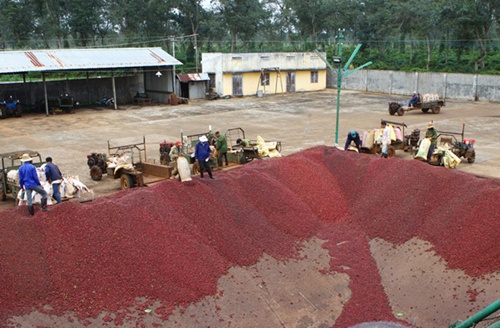Coffee industry in trouble as prices plunge
 |
| Coffee is loaded for processing at the Thang Loi Coffee Company. -VNA/VNS Photo Duong Giang |
"The international coffee market has seen unexpected trends and seriously impacted Vietnamese exports," Deputy Minister of Agriculture and Rural Development Le Quoc Doanh said at the 2015 Viet Nam Coffee Outlook and Sustainability Forum.
"We should find a way to cope with the situation to ensure the development of the industry."
This year the Vietnamese coffee industry has seen domestic prices fall relentlessly since the beginning of the year, an unusual trend.
"Sustainable coffee production continued to increase and replantation has been going up," Tran Cong Thang of the Institute of Policy and Strategy for Agriculture and Rural Development said.
In 2014 -15 the area under coffee was 641,700 hectares, almost the same as the previous year.
The Government plans to spend VND12 trillion (US$540 million) to replant coffee trees in five Central Highlands provinces, where the existing trees are aged 20 years in some places.
"Production costs decreased because labour, petrol and fertiliser costs went down," Thang said.
The cost per kilogramme has fallen from VND28,000 ($1.25) last year to VND22,181 ($0.99) now, he said.
"Exports in the first 10 months of 2015 were down 29.3 per cent in volume terms year-on-year and 31.1 per cent in value."
But Viet Nam remained the second largest exporter accounting for 18 per cent of all exports in 2014-15, compared with 22 per cent the previous year.
This year coffee exporters have found it difficult to buy since prices have fallen and farmers and agents do not want to sell.
"Low quality of coffee -- because farmers rarely invest in post-harvest technology — and exchange rate volatility cause risks to enterprises borrowing foreign currency to support their export activities," Thang said.
The lack of uniform coffee futures prices in the country, higher domestic prices compared to global prices and high bank interest rates of 7 per cent or more, and difficult lending procedures also plague exporters.
The area under coffee in 2015-2016 is expected to decrease by 30,500ha though output is likely to increase by 26,000 tonnes.
To address the industry's problems, Ted van de Put, member of the executive board of the Netherlands-based Sustainable Trade Initiative in Viet Nam released a report titled "Collective Impact for Sustainable Coffee Communities with vision 2020".
"We build a common public-private agenda to realise collective impact on large-scale challenges for the resilience and livelihoods of coffee farming communities and the sector as a whole," he said.
He said the Government should support public-private dialogue and collaboration in the national coffee sector strategy, strengthen existing/new platforms in countries with increased ownership by public sector and engagement and inclusion of the international and national private sectors.
In the field of national sustainability, he advised a public-private participatory process that identifies national and international priorities for achieving a healthy coffee sector.
The result would be a commonly endorsed basic farmer training materials and methodologies for sustainable, profitable production, he said.
"Financial literacy and access to finances is a must by promoting a basic level of financial literacy and access to finance for inputs, especially for smallholder farmers.
What the stars mean:
★ Poor ★ ★ Promising ★★★ Good ★★★★ Very good ★★★★★ Exceptional
Latest News
More News
- Growth beckons for GenAI startups in Vietnam (November 21, 2024 | 17:47)
- SABECO to elevate Vietnam's beverage industry to global standards (November 21, 2024 | 17:36)
- ABeam Consulting Vietnam introduces BSQCD Purchasing Strategy Framework (November 21, 2024 | 16:40)
- Major railway requires debt considerations (November 21, 2024 | 12:07)
- Reviving a new life cycle for plastic waste (November 21, 2024 | 09:16)
- Key balances maintained for industrial production (November 21, 2024 | 08:00)
- Ecolean Vietnam honoured with prestigious sustainability award (November 19, 2024 | 10:01)
- HEINEKEN Vietnam’s clear path towards net-zero (November 18, 2024 | 15:13)
- VLCA 2024 honours corporate governance excellence as listed companies raise the bar (November 18, 2024 | 09:00)
- High-tech personnel to drive competition (November 17, 2024 | 09:21)
















 Mobile Version
Mobile Version